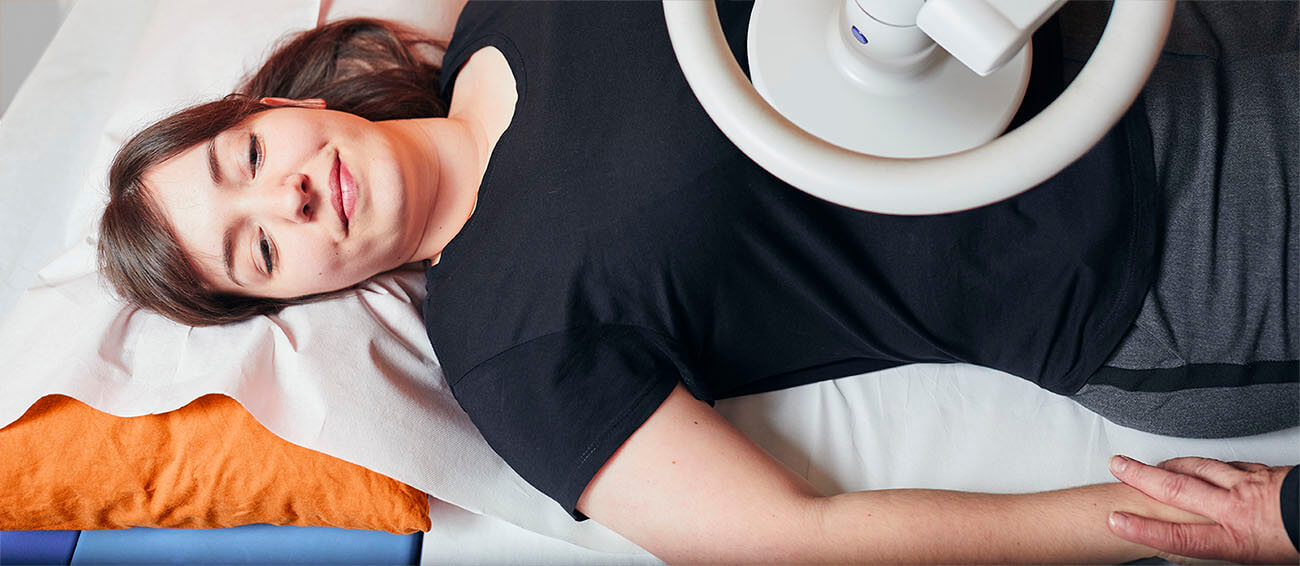
Patient experience of a regional hyperthermia session
If your doctor has recommended the use of regional hyperthermia, the treatment will be used as a complementary measure in the scope of the therapy combinations you are receiving. Hyperthermia can enhance the effect of radiation therapy and can help to improve the tolerability and efficacy of many chemotherapies. Moreover, it is a very interesting option when it comes to boosting your own immune system. There is good reason for a natural mechanism that increases our body temperature – fever.
What happens during a regional hyperthermia session? The first option among the available alternatives is to elevate the temperature as the least stressful variant. The treatment typically takes an hour, and a series of consecutive sessions is recommended. In the acute phase, this can include a sequence of up to two or three sessions a week. The frequency is significantly lower in the follow-up phase. If the tumor responds successfully, regardless of the therapy combination (surgery, chemotherapy, radiation), the use of hyperthermia is justified once a year or every six months in the follow-up phase in combination with other immunostimulatory treatments.
Preparation for the first and subsequent sessions
The good news is this: Hyperthermia treatment is not painful and will not hurt if everything is running properly. It is recommended to drink a glass of water before the treatment. You will be asked to set all metallic objects aside when you come into the treatment room. That is particularly important in your body treatment area. For example, if you are receiving treatment in the abdominal area, you would have to remove a belt with a metal buckle. Earrings or facial piercings can stay in. If you are receiving treatment in the chest area, all necklaces should be removed. Your skin must be exposed in the treatment area, but you can keep your remaining clothes on; it makes sense to remove your shoes. Since your wallet and mobile phone will interfere with the magnetic field, they should be set down outside of the patient bed. Unfortunately, it is typically not feasible to listen to music through headphones for the same reason.
You will now be positioned on the bed. The surface area of this bed consists of soft foam tiles. The staff will try to make your positioning as comfortable as possible, including with a knee roll, blankets and pillows. You will only be a bit more restricted in the treatment area. Feel free to let the staff know whether you are comfortable enough. Your positioning should feel really good!
Below the area of treatment, you will then be positioned over a water-filled structure that is located above the lower electrode. Don’t worry, there is no way you can accidentally come in direct contact with any electrical parts. In the beginning, the lower electrode typically bulges slightly upward and you may feel as if you’re lying on a “bump”. However, after the first few minutes, your body weight will slowly bear down on the water for a comfortable position. Your first impression will also be that the system is cold to the touch. We should explain that this is intentional because the water above the actual electrode is chilled in a special circuit. Most thermal receptors are located under the skin. If they are cooled, it is much easier to warm up the tissue deep in the body without any painful sensations for you.
An arm containing an analog electrode with another water cushion attached underneath it will now be moved in from the top. Since it must be snug on the body, this unit will initially be pushed down a little harder and then snaps into place about half a centimeter above the body. The hand-held patient feedback switch (lower blue button) that is permanently attached to the bed gives you the option to move the upper electrode upward at any time and to stop the treatment immediately. Sometimes – especially in the abdominal and chest area – the body sinks a little lower after 2-3 minutes and the upper electrode no longer sits fully on the skin. Tell the operating staff if that happens so they can readjust the system for optimal contact.
Actual treatment
Now that you are located between the upper and lower electrode, your body forms a so-called dielectric that is located between two voltage poles that change back and forth from positive to negative polarity 13 million times per second. This causes the water molecules in your body’s treatment area to rotate, which in turn leads to a temperature increase based on friction, from the inside out so to speak.
According to the treatment protocol, the power input is stepped up at certain times during the treatment (which generally lasts 60 minutes, as mentioned above). This is intended to counter physiological cooling effects (such as tissue expansion, vascular dilation and sweating). It is important that no sweat forms on your skin in the treatment area! Because sweating cannot be fully prevented, the thin cloth or gauze dressing frequently needs to be replaced with a fresh dry piece during the last third of the treatment. The treatment protocol also increases from session to session and your individual settings will be fully adjusted after about four treatment sessions.
If you are receiving very high power input (toward the end of the session), you may hear a short beep every minute. You would then push the top blue button on the above-mentioned patient safety switch as a sign that everything is OK and that you are feeling well. If that doesn’t happen within 15 seconds, the treatment will be interrupted.
Generally speaking, regional hyperthermia treatment is a pleasant experience. Many patients fall asleep during the treatment and find it wonderful. The silence and soothing absence of hustle and bustle offer a welcome hour of rest.
Side effects and after the treatment
When used properly, regional hyperthermia is a therapeutic procedure with hardly any side effects. You may feel a bit tired and be slow to react after the session, and minor dizziness has been reported in very few cases. All of these aspects typically disappear completely within two hours. Contraindications to regional hyperthermia include a pacemaker in the treatment area, but your doctor is familiar with all of these concerns.
Ask your doctor if you have any further questions or contact us at Celsius42 GmbH with your general questions by sending an email to info@celsius42.de.
